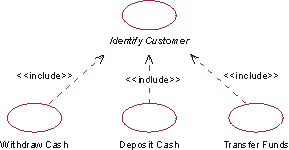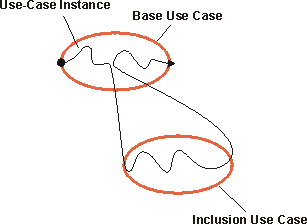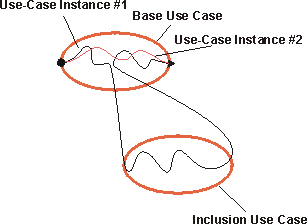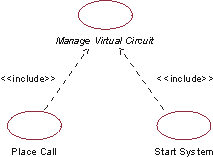Guidelines:
Include-Relationship
«include»

Include-Relationship |
An
include-relationship is a relationship from a base use case to an
inclusion use case, specifying how the behavior defined for the inclusion
use case is explicitly inserted into the behavior defined for the base use
case. |
Topics
The include-relationship connects a base use case to an inclusion use case.
The inclusion use case is always abstract. It describes a behavior segment that
is inserted into a use-case instance that is executing the base use case. The
base use case has control of the relationship to the inclusion and can depend on
the result of performing the inclusion, but neither the base nor the inclusion
may access each other's attributes. The inclusion is in this sense encapsulated,
and represents behavior that can be reused in different base use cases.
You can use the include-relationship to:
- Factor out behavior from the base use case that is not necessary for the
understanding of the primary purpose of the use case, only the result of it
is important.
- Factor out behavior that is in common for two or more use cases.
Example:
In an ATM system, the use cases Withdraw Cash, Deposit Cash,
and Transfer Funds all need to include how the customer is identified to the
system. This behavior can be extracted to a new inclusion use case called
Identify Customer, which the three base use cases include. The base use cases
are independent of the method used for identification, and it is therefore
encapsulated in the inclusion use case. From the perspective of the base use
cases, it does not matter whether the method for identification is to read a
magnetic bank card, or perform a retinal scan. They only depend on the result of
Identify Customer, which is the identity of the customer. And vice versa, from
the perspective of the Identify Customer use case, it does not matter how the
base use cases use the customer identity or what has happened in them before the
inclusion is executed – the method for identification is still exactly the
same.

In the ATM system, the use cases Withdraw Cash, Deposit
Cash, and Transfer Funds all include the use case Identify Customer.
A base use case may have multiple inclusions. One inclusion use case may be
included in several base use cases. This does not indicate any relationship
between the base use cases. You may even have multiple include-relationships
between the same inclusion use case and base use case, provided the inclusion is
inserted at different locations of the base use case. The include-relationship
defines what the location is. All additions may be nested, which means that an
inclusion use case may serve as the base use case for another inclusion.
Since the inclusion use case is abstract, it does not need to have an actor
associated with it. A communication-association to an actor is only needed if
the behavior in the inclusion explicitly involves interaction with an actor.
The behavior of the inclusion is inserted in one location in the base use
case. When a use-case instance following the description of a base use case
reaches a location in the base use case from which include-relationship is
defined, it will follow the description of the inclusion use case instead. Once
the inclusion is performed, the use-case instance will resume where it left off
in the base use case.

A use-case instance following the description of a base
use case including its inclusion.
The include-relationship is not conditional: if the use-case instance reaches
the location in the base use case for which it is defined, it is always
executed. If you want to express a condition, you need to do that as part of the
base use case. If the use-case instance never reaches the location for which the
include-relationship is defined, it will not be executed.

Use-case instance #1 reaches the location in the base use
case for which the include-relationship is defined, and the inclusion is
performed. Use-case instance #2 does not reach that location, and the inclusion
is therefore not performed as part of that instance.
The inclusion use case is one continuous segment of behavior, all of which is
included at one location in the base use case. If you have separate segments of
behavior that need to be inserted at different locations, you should consider
the extend-relationship (see Guidelines:
Extend-Relationship) or the use-case-generalization (see Guidelines:
Use-Case-Generalization) instead.
For the include-relationship, you should define the location within in the
behavior sequence of the base use case where the inclusion is to be inserted.
The location can be defined by referring to a particular step or subflow within
the flow of events of the base use case.
Example:
In the ATM system, the use case Withdraw Cash includes the
use case Identify Customer. The include-relationship from Withdraw Cash to
Identify Customer can be described as follows:
Identify Customer is inserted between sections 1.1 Start of
Use Case and 1.2 Ask for Amount in the flow of events of Withdraw Cash.
For the sake of clarity, you should also mention the inclusion in the text
describing the flow of events of the base use case.
If there is a behavior segment in a use case where you can see that the use
case is not dependent on how things are done, but it is dependent on the result
of the function, you can simplify the use case by extracting this behavior to an
inclusion use case. The inclusion use case can be included in several base use
cases, which means it lets you reuse behavior among use cases in the model.
Consider the following step-by-step outlines to use cases for a simple phone
system:
Place Call
- Caller lifts the receiver.
- System presents a dial-tone.
- Caller dials a digit.
- System turns off dial-tone.
- Caller enters remainder of number.
- System analyzes the digits, and determines the network address of the
Receiving Party.
- System determines whether a virtual circuit can be
established between the Caller and the Receiving Party.
- System allocates all resources for virtual circuit
and establishes connection.
- System rings Receiving Party’s phone.
- And so on.
Start System
- Operator activates the system.
- System performs diagnostic tests on all components.
- System tests connections all adjacent systems. For each adjacent system,
the System determines whether a virtual circuit can be
established between itself and the adjacent system. The System allocates all
resources for the virtual circuit and establishes connection.
- System responds that it is ready for operation.
- And so on.
The text listed in blue is very similar; in both cases we are performing the
same behavior, although for very different reasons. This similarity can be
exploited, and we can extract the common behavior into a new use case, Manage
Virtual Circuits.
Once common behavior has been extracted, the use cases become:
Place Call
- Caller lifts receiver.
- System presents dial-tone.
- Caller dials a digit.
- System turns off dial-tone.
- Caller enters remainder of number.
- System analyzes digits, determines network address of the Receiving Party.
- Include the Manage Virtual Circuit use case to establish connectivity
within the network.
- System rings the Receiving Party’s phone.
- And so on.
Start System
- Operator activates system.
- System performs diagnostic tests on all components.
- System tests connections all adjacent systems. For each adjacent system
(loop), include Manage Virtual Circuit to establish connectivity with the
network.
- System responds that it is ready for operation.
- And so on.
In a use-case diagram, the include-relationship that is created will be
illustrated as follows:

The use cases Place Call and Start System both include
the behavior of the abstract use case Manage Virtual Circuit.
Copyright
© 1987 - 2001 Rational Software Corporation
|  Artifacts >
Artifacts >
 Requirements Artifact Set >
Requirements Artifact Set >
 Use-Case Model... >
Use-Case Model... >
 Use-Case Model >
Use-Case Model >
 Guidelines >
Guidelines >
 Include-Relationship
Include-Relationship
 Artifacts >
Artifacts >
 Requirements Artifact Set >
Requirements Artifact Set >
 Use-Case Model... >
Use-Case Model... >
 Use-Case Model >
Use-Case Model >
 Guidelines >
Guidelines >
 Include-Relationship
Include-Relationship